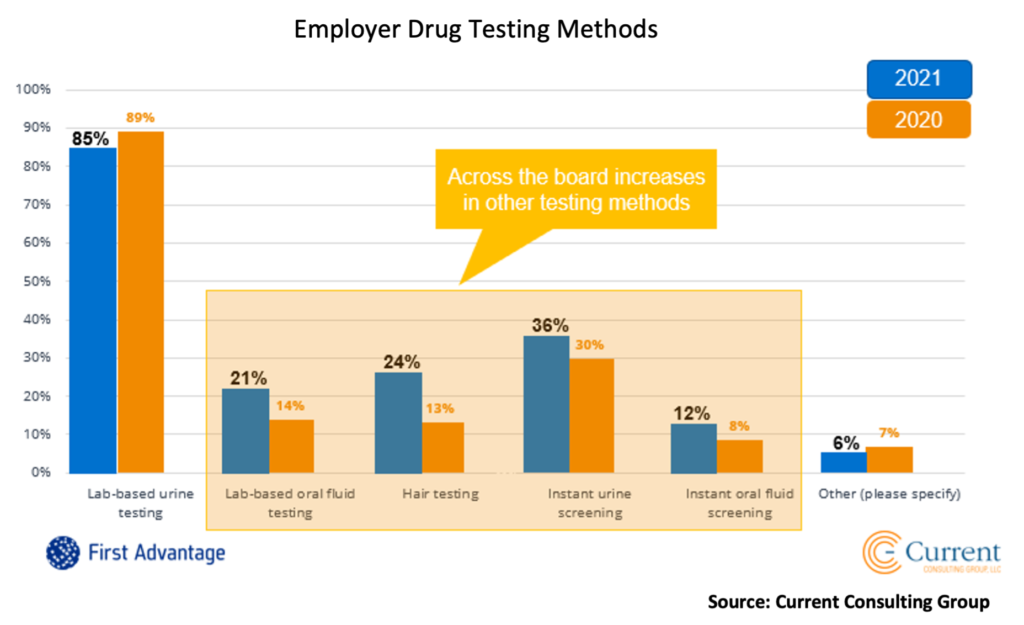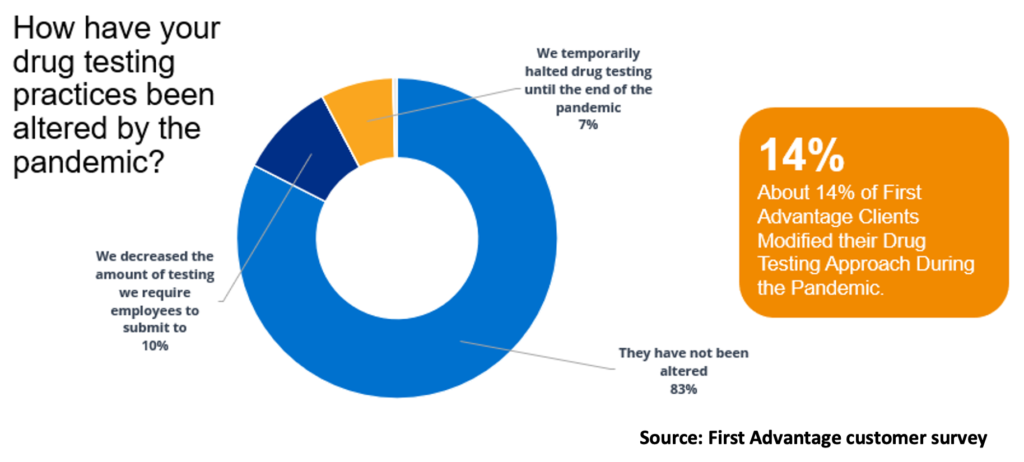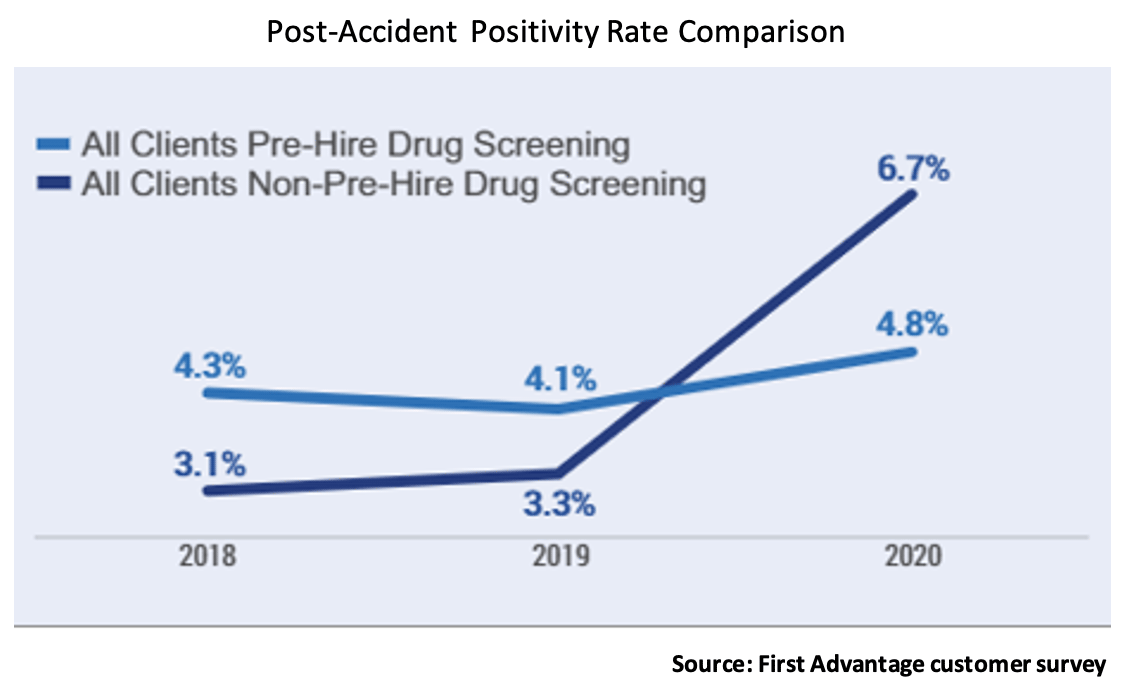In the past year or so since COVID-19 challenged our world, a lot has changed in the workplace. Employer drug testing is no exception, which is what makes the most recent survey from the drug screening experts at Current Consulting Group so illuminating. While most employers stayed the course, the survey showed that there are a few interesting shifts and resulting compromises that could put employers at increased risk.
If you’re wondering about the latest benchmarks in workplace drug testing, here are a few highlights and takeaways from the survey.
Dominant trends remain consistent, with a few subtle shifts. Most employers, roughly 98 percent, are performing some form of drug screening on their employees, for the same top three reasons they’ve been doing it for years: 1) to promote a safe and healthy workplace; 2) for compliance reasons; and 3) to mitigate legal risk.
Lab-based urine testing, the gold standard for drug testing, remains the dominant drug testing method, but it notably slipped a few percentage points from 89 percent in 2020 to 85 percent in 2021. Meanwhile, employer use of less intrusive testing methods—lab-based oral fluid, hair testing, instant urine, and instant oral fluid testing—increased. Likely due to pandemic-related logistics and health concerns, it’s been harder to get traditional testing done, and many collection sites have also been performing COVID-19 testing. In response, employers compensated by moving to other testing options.

Trend alert: instant oral fluid testing
We see interesting movement in instant oral fluid testing. Apart from its increased use in 2021, employers are indicating they plan to use this drug testing method even more in the future.
- When asked about anticipated drug screening program changes in the next 24 months, 89.6 percent said they aren’t planning any changes; however, of the employers who indicated they were considering changes, the second largest survey response came from the 5.56 percent who are considering adding oral fluid testing.
- More than one-third of the survey respondents, 34 percent, said they will likely add oral fluid testing when the DOT adds lab-based oral fluid as an accepted testing specimen. Another 45 percent didn’t rule it out; instead, indicating they’re not sure and may simply need to learn more about it.
- Of those employers who plan to modify their testing program based on the recently released lab-based oral fluid guidelines from SAMHSA, or the anticipated guidelines from DOT, 44.3 percent say they’ll add it to their current testing program.
The motivation behind this trend is simple. For employers, it’s all about having federally endorsed drug testing options that are highly effective and legally defensible. What’s more, instant oral fluid testing is extremely candidate-friendly, which can help differentiate employers in today’s ultra-competitive hiring market. It also helps them hire and onboard more workers faster than traditional testing methods. This is critical, as many employers are trying to ramp up hiring so they can return to normal, pre-pandemic operations, while others are prepping for the holiday season.
Beware of changing mindsets, and the consequences.
The unique confluence of the pandemic and the ongoing expansion of state marijuana laws, especially related to the recreational use of marijuana, is driving risky trends among a small portion of employers. Roughly 2 percent of employers responding to the Current Consulting Group survey indicate they have halted all drug testing—including pre-employment—while 9 percent say they’re removing marijuana altogether from their testing panels in the next year, up from 5 percent in 2020.
- A separate First Advantage customer survey reveals that 14 percent of employers modified their drug testing program during the COVID-19 pandemic, with 7 percent indicating that they stopped all drug testing during the pandemic.

Despite the perceived inconveniences of drug screening during a pandemic, the consequences of stopping can be costly. After a 15 percent decrease in drug testing from 2019 to 2020 for First Advantage clients, post-accident positivity rates soared by 17 percent across all industries. In the transportation industry, rates skyrocketed 74 percent compared to the prior year.This trend is even more pronounced when we compare post-accident positivity rates for customers who did perform pre-hire testing with those who did not. For those who did, their post-accident positivity rate rose 17 percent; however, the positivity rate doubled for those who did not perform pre-hire drug testing during that same time. The message here is clear: pre-employment drug testing can help mitigate on-the-job substance abuse that leads to increased workplace risk and accidents.
- As for marijuana testing, a small but growing percentage of employers are removing it from their testing panel according to the Current Consulting Group survey, with 35 percent citing concerns about lawsuits and legal liability. This, despite significant and growing concerns about the impact of employee marijuana use on workplace safety, the quality of new hires and a range of operational costs.

As of the publication date of this blog article, 38 states and territories (including the District of Columbia and Puerto Rico) have implemented laws to address medical marijuana use; 17 states have implemented clauses or protections to address employee or candidate non-discrimination related to marijuana use; and 19 states have implemented laws related to recreational marijuana use.
However, marijuana testing for employment purposes remains legal in every state, with a few restrictions in some areas. As a Schedule I substance under the Controlled Substances Act, marijuana has a high potential for abuse and can impair employees for several hours after use, leading to a plethora of workplace risks. Employers with a vested interest in promoting workplace safety are strongly encouraged to continue testing for marijuana and consult with their in-house legal counsel on specific screening restrictions and guidelines.
For more information, including the latest insights on alcohol testing, positivity rates by state and much more delivered with expert commentary from top industry professionals, listen to the webinar, In the Weeds on Today’s Drug Testing Landscape. What are Employers Doing? WATCH NOW



